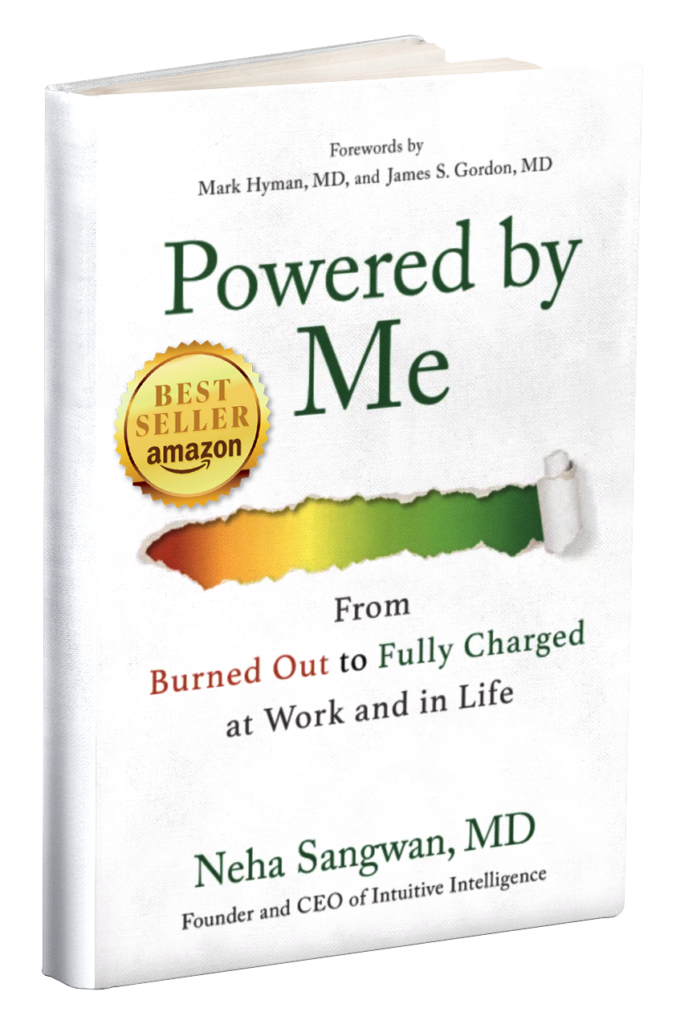DOWNLOAD THE MP3 | LISTEN ON iTUNES
Doctor Neha: Hi everybody. Today’s TalkRx has a really special guest. This is my little niece who’s invited us all into her room with her little teepee. She is going to teach us a little bit today. At the end, Simrin, I’m going to ask you for some of your lessons and your takeaways, but I want to tell the story about when you were in kindergarten and your friend by mistake bit you. We got a phone call when we came home. When you were in kindergarten, you were five years old. You’re now about eight. When you were in that class, how did the teachers teach you to be quiet? What did they do?
Simrin: They would give us a symbol.
Doctor Neha: OK. Speak up loud and tell people what kind of symbol the teachers gave you.
Simrin: [Holding up her in hand and making a circle sign with her fingers] A zero.
Doctor Neha: Zero. So zero noise. So when, when they put their hand up like that, it meant zero noise. So one day we got on a phone call from Simrin’s teacher asking my younger sister what she did for a living. My sister said, “Oh, what did Simrin do today in school? Why are you asking?” The teacher replied, “Well, it was really interesting…” and she started to tell this story.
Simrin has a friend in school who was telling her a story. Imagine that friend sitting in front of Simrin looking back at her, so she has her back to the teacher. Her friend was telling her a story and she’s really excited. Simrin’s listening, and all of a sudden, Ms. Babbage does what?
Simrin: [Holds up the zero noise symbol]
Doctor Neha: Ms. Babbage comes up behind her friend, and she puts the zero noise sign up. So Simrin puts the zero noise up. But her friend is really excited and she’s telling the story, and she wants to just finish it. Simrin takes her hand and does this zero noise symbol right in her face. Right? And when she does that, this little girl bites her hand. Oh my goodness! As soon as she bites her hand, Simrin starts crying, the little girl starts crying and gets up and runs out of the classroom. Then her teacher comes running over to Simrin and said, “Are you OK?” So the teacher has her move her hand and says, “We’ll see what it looks like. You’re OK.” And Simrin says this, “Mrs. Babbage, it’s not OK if she’s outside crying—you and me we’re not OK.” So the teacher takes Simrin by the hand outside to where her friend is having a full meltdown. The teacher says,”Hey, Keisha, Simrin wants to talk to you. She wants to say something.” Keisha says, “No, no, no, no.” And do you remember what you said to her Simrin?
Simrin: I kind of do but I want you to share it.
Doctor Neha: OK, this is what the teacher told us. She said that you put your hand on her shoulder and said, “It’s OK, Keisha. It sounds like you need to cry it out or yell it out. When you’re done I want you to know that we’re inside and I’ll talk it out with you when you’re ready.”
Simrin turned around and walked back in the room. The teacher said she was stunned. I’m so proud of you because you know that we’re all connected, so when one of us isn’t OK, then you’re not OK. Right? And so in conflict you were willing to lean in and be with the emotions and willing to give Keisha some time with her emotions. Did you then make friends with her again?
Simrin: Yeah.
Doctor Neha: So tell me some lessons that you’ve learned about emotions or what’s important.
Simrin: It’s called empathy. And the most simplest way of phrasing it is actually like pretending that like you’re walking in someone else’s shoes.
Doctor Neha: Where did you learn that? Because that’s not how I say it. So tell me where you learned that from.
Simrin: My new school.
Doctor Neha: So if there was one important thing that could help kids in communication with each other besides empathy, what would it be? What do you think about emotion?
Simrin: Tell us about their feelings and your feelings. Really listened to them and recognize their feelings and whatever they’re feeling. It’s true.
Doctor Neha: And sometimes if someone’s having a really strong feeling in the moment, you let them have it, right? You let them yell it out or cry it out sometimes. Do you have to do that sometimes?
Simrin: Yeah.
Doctor Neha: Well, I’m really proud of you and I’m so glad. Do you remember some books that helped you, that I used to read you.
Simrin: It’s happy and sad monster. Moths in the stomach. And your butterflies in your tummy to help you with your anxiety.
Doctor Neha: Bye-Bye Butterflies By Lilita Matison is one. And then you were talking about Glad Monster, Sad Monster.
If we could teach children young to lean into their emotions, to care about other people, and to understand that we’re all connected, we’d have a different world. Thank you once again, Simrin, for doing this with me being such a brave soul and thanks for letting us into your room..
All You Ever Needed to Know From a 5-Year-Old
- Use empathy by walking in someone else’s shoes.
- Listen and recognize their feelings.
- If your feelings or their feelings are strong, you might need to yell it out or cry it out first. And that’s okay.
Simrin & Neha’s Favorite Children’s Books

Glad Monster, Sad Monster

Bye Bye Butterflies: 7 Ways to Breathe Out Worry

Tickle Monster

Of Thee I Sing

Chris P. Bacon

ISH





